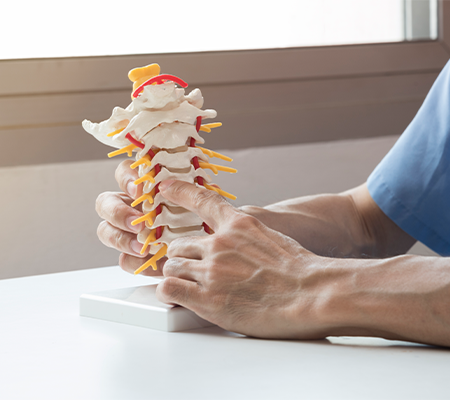
Cervical spine fusion removes a damaged disc, creating a space filled with titanium and/or bone graft that will grow to fuse the two adjoining vertebrae together. This is done to remove any materials compressing the nerves and spinal cord and provide stability.
You likely do not need surgery if you’re experiencing neck pain alone. However, if you have pain or weakness running down one arm, trouble with your balance or decreasing ability to use your hands, your surgeon will look at treatment options that include cervical spine fusion.
The most common reasons why a person may need cervical spine fusion is degeneration of the cervical spine disc due to aging or trauma. The cervical spine is seven vertebral segments. A fusion joins two or more of those segments together so they no longer move independent of each other. Your doctor will determine the number of segments they will fuse based on what is causing the issue.
Focus on non-operative treatments first
The muscles in your upper back and shoulders are important to your neck or cervical spine health. It takes significant energy and strength to keep your head upright. Weakness in those muscles could contribute to pain and mobility issues. “We recommend physical therapy to focus on those muscles to strengthen them as a first measure of treatment,” said Dr. Nikhil Shelke, neurosurgical and orthopedic spine surgeon for Marshfield Clinic Health System.
Steroid injections in the neck or other medications to treat pain are additional non-operative methods of treatment.
Bone health and lifestyle are indicators for good surgical candidates
One of the biggest concerns for surgery is if the patient smokes. Research shows smoking negatively impacts healing. It decreases the successful outcome of the surgery. Other health conditions like poor bone quality or increased weight will produce less favorable outcomes. Your surgeon may recommend health and lifestyle changes before recommending surgery.
There are two types of surgeries. When your surgeon operates on the front of the neck, it is an anterior cervical fusion. It is a posterior cervical fusion if they operate through an incision in the back of your neck. When people have an anterior surgery, they often have more pain in the back of their neck for up to six weeks after surgery. “I relate this to my patients where it’s similar to wearing braces in their mouth,” Dr. Shelke said. “In an anterior surgery I have changed the alignment of their neck, which is why their bones hurt until they get used to the new position.”
Patients might have trouble swallowing or voice hoarseness for a few days after surgery. This occurs when nerves or your esophagus is strained due to the nature of the small space during the operation. These side effects can improve over time and very rarely are long lasting.
Surgery’s goal is to restore quality of life
Immediately after surgery, patients are encouraged to take it easy for the first two weeks to allow healing. Most people don’t require a collar after surgery. Dr. Shelke recommends no forceful bending or twisting side to side or up and down and limited lifting for 12 weeks.
During recovery, patients will attend physical therapy to gain strength and mobility. After 12 weeks, the goal is for patients to be back doing their normal activities. “Unless they are looking at extreme activities that could pose a risk like bungee jumping or sky diving, we want patients to be back to doing what they enjoy,” Dr. Shelke said.
If you have continued neck pain or discomfort, see your doctor.
Related Shine365 Stories
Disk-function: Dealing with a herniated disk






Leave a Reply